Headspace NewAccess Project: System Analysis, Cloud Solutions & SDLC
VerifiedAdded on 2023/04/04
|12
|2307
|116
Report
AI Summary
This report provides a system analysis of the Headspace NewAccess project, a mental health intervention targeting young people. It explores non-functional requirements using the FURPS+ model, reviews the strengths and weaknesses of cloud-based solutions for data storage and accessibility, and evaluates predictive and adaptive SDLC approaches. The report recommends an adaptive SDLC approach due to its flexibility and user-centric nature, which aligns well with the project's reliance on input from various stakeholders, including medical staff and patients. The analysis considers factors like system qualities, user interfaces, system constraints, security, and reliability to provide a comprehensive overview of the project's technical considerations. The report concludes that the adaptive SDLC approach is best suited for ensuring transparency and accommodating evolving requirements throughout the project lifecycle.
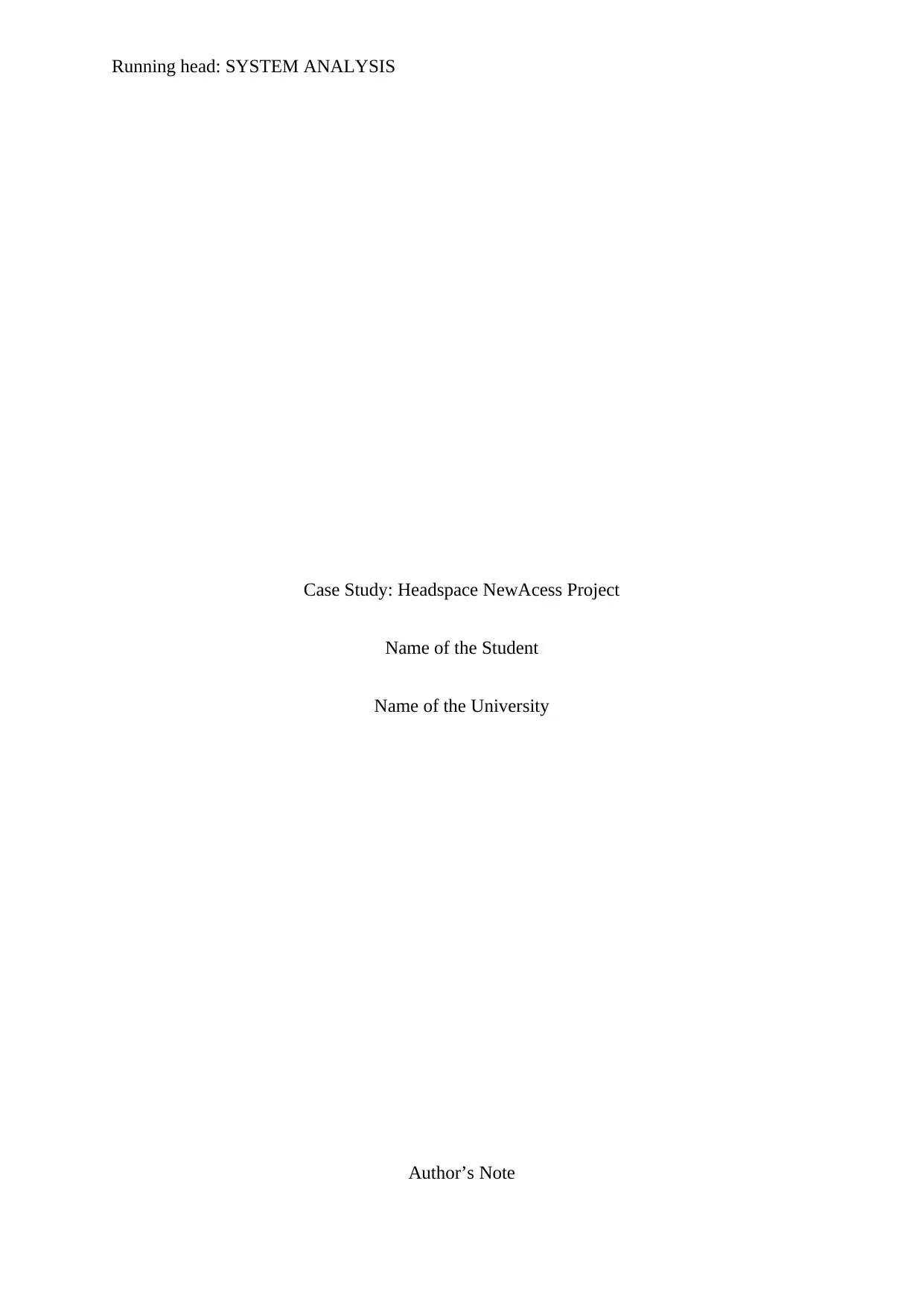
Running head: SYSTEM ANALYSIS
Case Study: Headspace NewAcess Project
Name of the Student
Name of the University
Author’s Note
Case Study: Headspace NewAcess Project
Name of the Student
Name of the University
Author’s Note
Paraphrase This Document
Need a fresh take? Get an instant paraphrase of this document with our AI Paraphraser
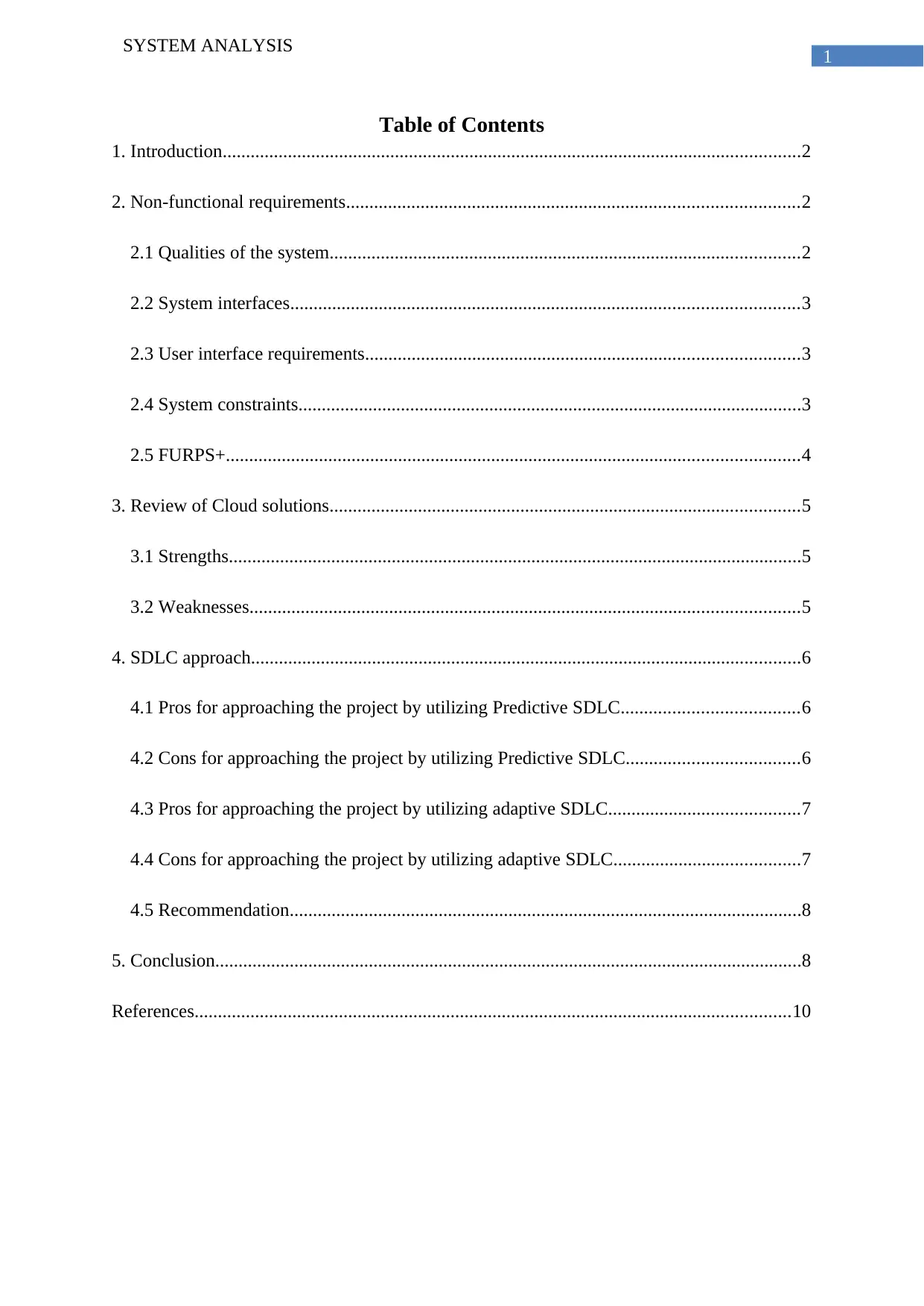
1
SYSTEM ANALYSIS
Table of Contents
1. Introduction............................................................................................................................2
2. Non-functional requirements.................................................................................................2
2.1 Qualities of the system.....................................................................................................2
2.2 System interfaces.............................................................................................................3
2.3 User interface requirements.............................................................................................3
2.4 System constraints............................................................................................................3
2.5 FURPS+...........................................................................................................................4
3. Review of Cloud solutions.....................................................................................................5
3.1 Strengths...........................................................................................................................5
3.2 Weaknesses......................................................................................................................5
4. SDLC approach......................................................................................................................6
4.1 Pros for approaching the project by utilizing Predictive SDLC......................................6
4.2 Cons for approaching the project by utilizing Predictive SDLC.....................................6
4.3 Pros for approaching the project by utilizing adaptive SDLC.........................................7
4.4 Cons for approaching the project by utilizing adaptive SDLC........................................7
4.5 Recommendation..............................................................................................................8
5. Conclusion..............................................................................................................................8
References................................................................................................................................10
SYSTEM ANALYSIS
Table of Contents
1. Introduction............................................................................................................................2
2. Non-functional requirements.................................................................................................2
2.1 Qualities of the system.....................................................................................................2
2.2 System interfaces.............................................................................................................3
2.3 User interface requirements.............................................................................................3
2.4 System constraints............................................................................................................3
2.5 FURPS+...........................................................................................................................4
3. Review of Cloud solutions.....................................................................................................5
3.1 Strengths...........................................................................................................................5
3.2 Weaknesses......................................................................................................................5
4. SDLC approach......................................................................................................................6
4.1 Pros for approaching the project by utilizing Predictive SDLC......................................6
4.2 Cons for approaching the project by utilizing Predictive SDLC.....................................6
4.3 Pros for approaching the project by utilizing adaptive SDLC.........................................7
4.4 Cons for approaching the project by utilizing adaptive SDLC........................................7
4.5 Recommendation..............................................................................................................8
5. Conclusion..............................................................................................................................8
References................................................................................................................................10
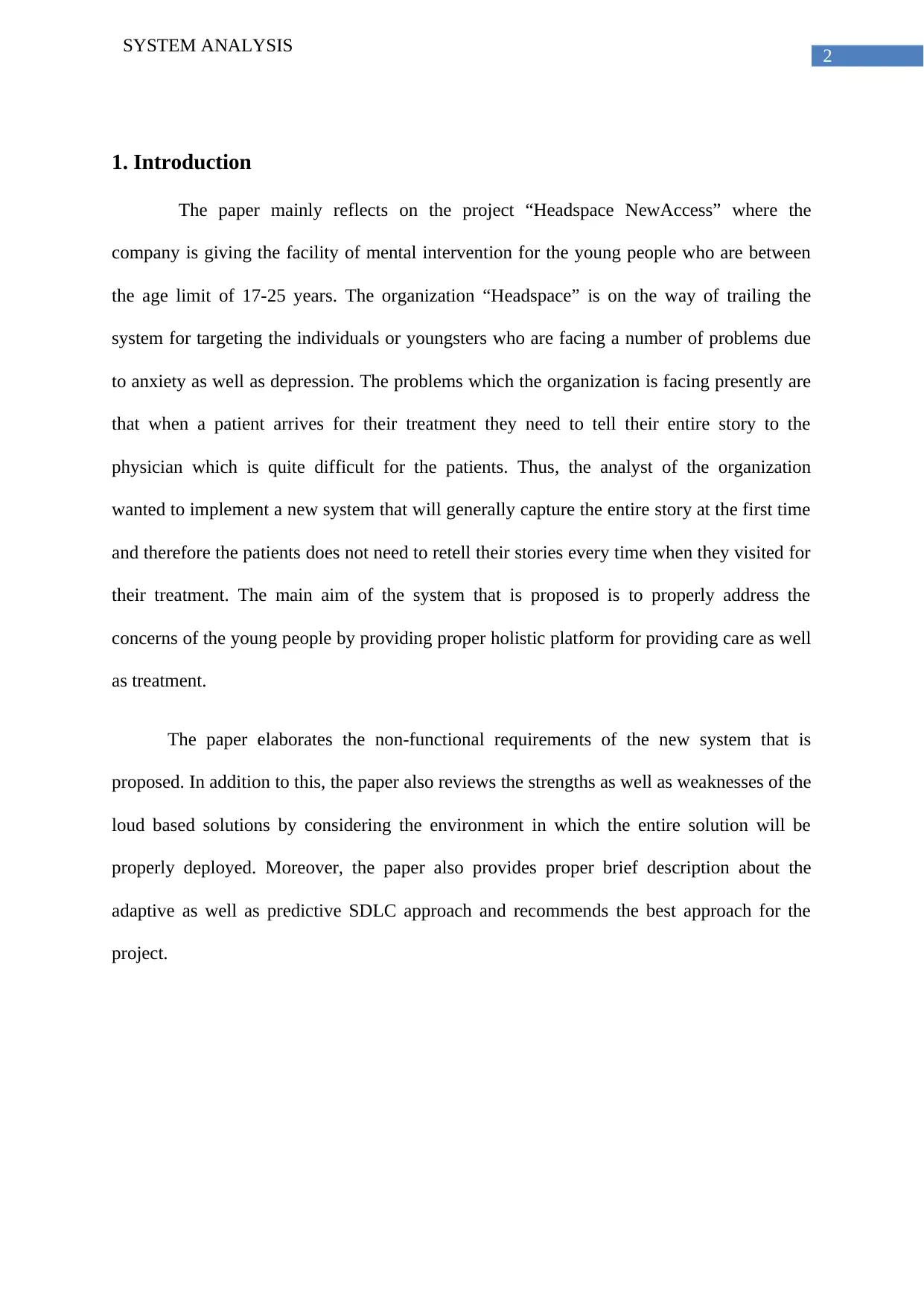
2
SYSTEM ANALYSIS
1. Introduction
The paper mainly reflects on the project “Headspace NewAccess” where the
company is giving the facility of mental intervention for the young people who are between
the age limit of 17-25 years. The organization “Headspace” is on the way of trailing the
system for targeting the individuals or youngsters who are facing a number of problems due
to anxiety as well as depression. The problems which the organization is facing presently are
that when a patient arrives for their treatment they need to tell their entire story to the
physician which is quite difficult for the patients. Thus, the analyst of the organization
wanted to implement a new system that will generally capture the entire story at the first time
and therefore the patients does not need to retell their stories every time when they visited for
their treatment. The main aim of the system that is proposed is to properly address the
concerns of the young people by providing proper holistic platform for providing care as well
as treatment.
The paper elaborates the non-functional requirements of the new system that is
proposed. In addition to this, the paper also reviews the strengths as well as weaknesses of the
loud based solutions by considering the environment in which the entire solution will be
properly deployed. Moreover, the paper also provides proper brief description about the
adaptive as well as predictive SDLC approach and recommends the best approach for the
project.
SYSTEM ANALYSIS
1. Introduction
The paper mainly reflects on the project “Headspace NewAccess” where the
company is giving the facility of mental intervention for the young people who are between
the age limit of 17-25 years. The organization “Headspace” is on the way of trailing the
system for targeting the individuals or youngsters who are facing a number of problems due
to anxiety as well as depression. The problems which the organization is facing presently are
that when a patient arrives for their treatment they need to tell their entire story to the
physician which is quite difficult for the patients. Thus, the analyst of the organization
wanted to implement a new system that will generally capture the entire story at the first time
and therefore the patients does not need to retell their stories every time when they visited for
their treatment. The main aim of the system that is proposed is to properly address the
concerns of the young people by providing proper holistic platform for providing care as well
as treatment.
The paper elaborates the non-functional requirements of the new system that is
proposed. In addition to this, the paper also reviews the strengths as well as weaknesses of the
loud based solutions by considering the environment in which the entire solution will be
properly deployed. Moreover, the paper also provides proper brief description about the
adaptive as well as predictive SDLC approach and recommends the best approach for the
project.
⊘ This is a preview!⊘
Do you want full access?
Subscribe today to unlock all pages.

Trusted by 1+ million students worldwide
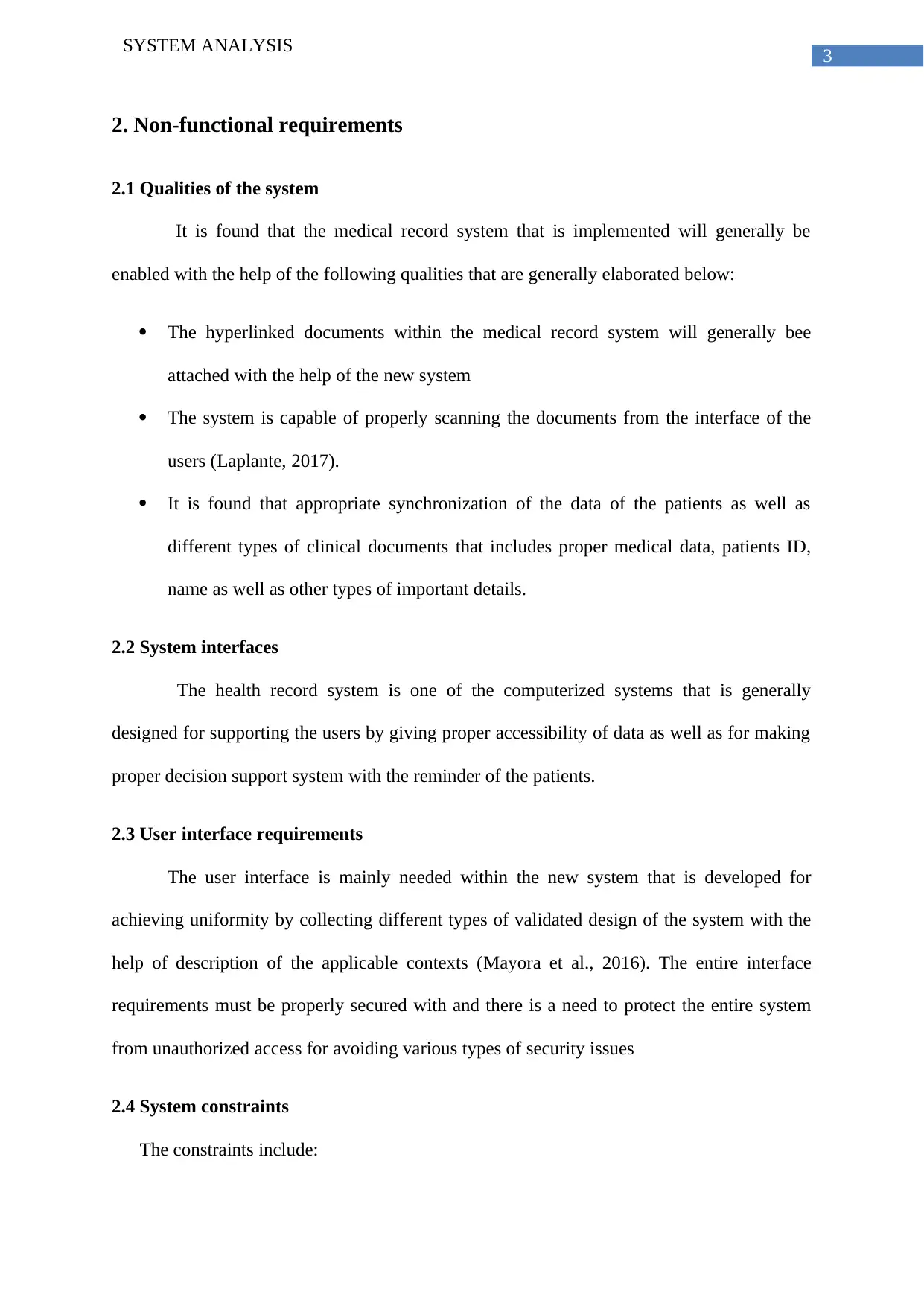
3
SYSTEM ANALYSIS
2. Non-functional requirements
2.1 Qualities of the system
It is found that the medical record system that is implemented will generally be
enabled with the help of the following qualities that are generally elaborated below:
The hyperlinked documents within the medical record system will generally bee
attached with the help of the new system
The system is capable of properly scanning the documents from the interface of the
users (Laplante, 2017).
It is found that appropriate synchronization of the data of the patients as well as
different types of clinical documents that includes proper medical data, patients ID,
name as well as other types of important details.
2.2 System interfaces
The health record system is one of the computerized systems that is generally
designed for supporting the users by giving proper accessibility of data as well as for making
proper decision support system with the reminder of the patients.
2.3 User interface requirements
The user interface is mainly needed within the new system that is developed for
achieving uniformity by collecting different types of validated design of the system with the
help of description of the applicable contexts (Mayora et al., 2016). The entire interface
requirements must be properly secured with and there is a need to protect the entire system
from unauthorized access for avoiding various types of security issues
2.4 System constraints
The constraints include:
SYSTEM ANALYSIS
2. Non-functional requirements
2.1 Qualities of the system
It is found that the medical record system that is implemented will generally be
enabled with the help of the following qualities that are generally elaborated below:
The hyperlinked documents within the medical record system will generally bee
attached with the help of the new system
The system is capable of properly scanning the documents from the interface of the
users (Laplante, 2017).
It is found that appropriate synchronization of the data of the patients as well as
different types of clinical documents that includes proper medical data, patients ID,
name as well as other types of important details.
2.2 System interfaces
The health record system is one of the computerized systems that is generally
designed for supporting the users by giving proper accessibility of data as well as for making
proper decision support system with the reminder of the patients.
2.3 User interface requirements
The user interface is mainly needed within the new system that is developed for
achieving uniformity by collecting different types of validated design of the system with the
help of description of the applicable contexts (Mayora et al., 2016). The entire interface
requirements must be properly secured with and there is a need to protect the entire system
from unauthorized access for avoiding various types of security issues
2.4 System constraints
The constraints include:
Paraphrase This Document
Need a fresh take? Get an instant paraphrase of this document with our AI Paraphraser
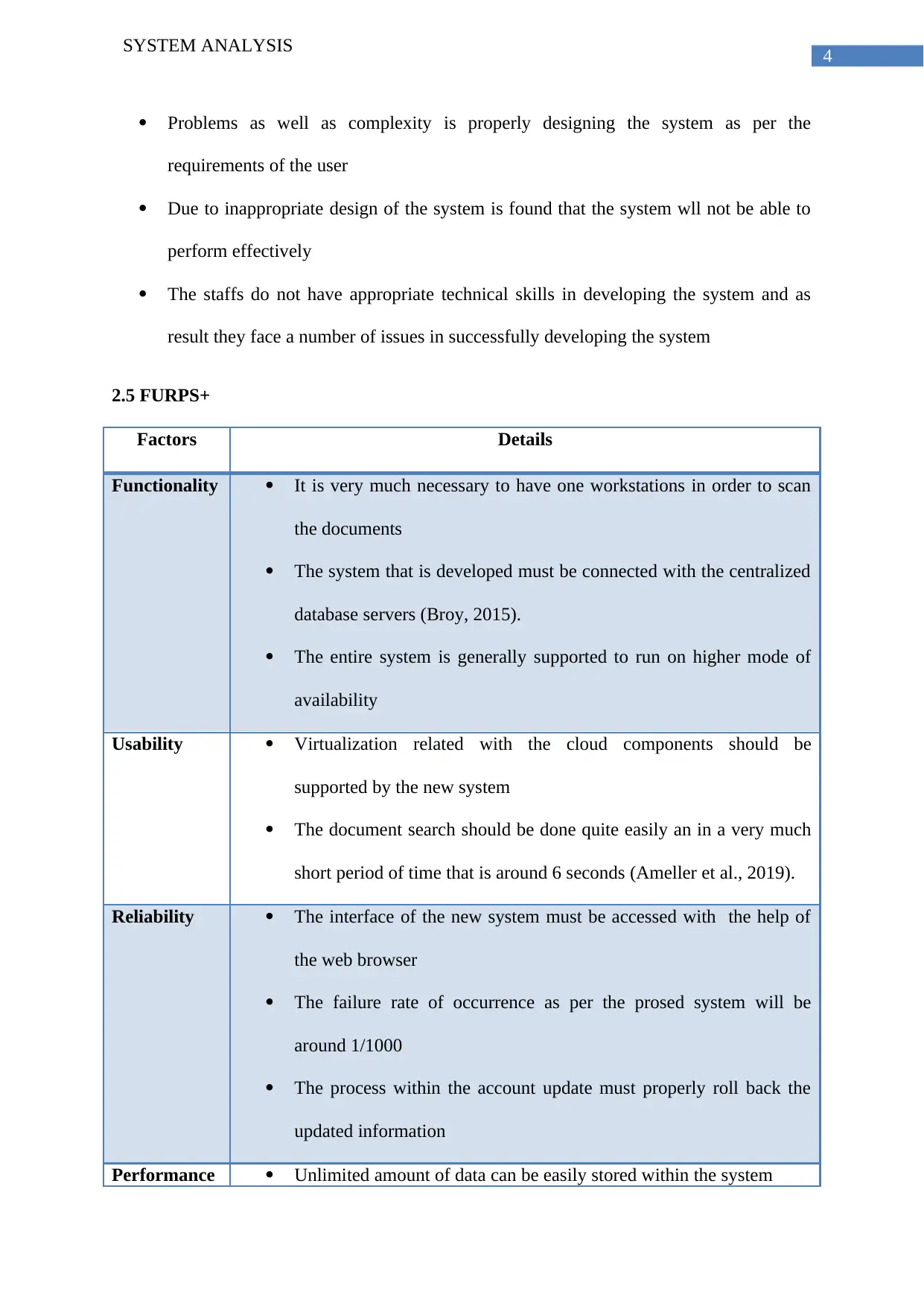
4
SYSTEM ANALYSIS
Problems as well as complexity is properly designing the system as per the
requirements of the user
Due to inappropriate design of the system is found that the system wll not be able to
perform effectively
The staffs do not have appropriate technical skills in developing the system and as
result they face a number of issues in successfully developing the system
2.5 FURPS+
Factors Details
Functionality It is very much necessary to have one workstations in order to scan
the documents
The system that is developed must be connected with the centralized
database servers (Broy, 2015).
The entire system is generally supported to run on higher mode of
availability
Usability Virtualization related with the cloud components should be
supported by the new system
The document search should be done quite easily an in a very much
short period of time that is around 6 seconds (Ameller et al., 2019).
Reliability The interface of the new system must be accessed with the help of
the web browser
The failure rate of occurrence as per the prosed system will be
around 1/1000
The process within the account update must properly roll back the
updated information
Performance Unlimited amount of data can be easily stored within the system
SYSTEM ANALYSIS
Problems as well as complexity is properly designing the system as per the
requirements of the user
Due to inappropriate design of the system is found that the system wll not be able to
perform effectively
The staffs do not have appropriate technical skills in developing the system and as
result they face a number of issues in successfully developing the system
2.5 FURPS+
Factors Details
Functionality It is very much necessary to have one workstations in order to scan
the documents
The system that is developed must be connected with the centralized
database servers (Broy, 2015).
The entire system is generally supported to run on higher mode of
availability
Usability Virtualization related with the cloud components should be
supported by the new system
The document search should be done quite easily an in a very much
short period of time that is around 6 seconds (Ameller et al., 2019).
Reliability The interface of the new system must be accessed with the help of
the web browser
The failure rate of occurrence as per the prosed system will be
around 1/1000
The process within the account update must properly roll back the
updated information
Performance Unlimited amount of data can be easily stored within the system
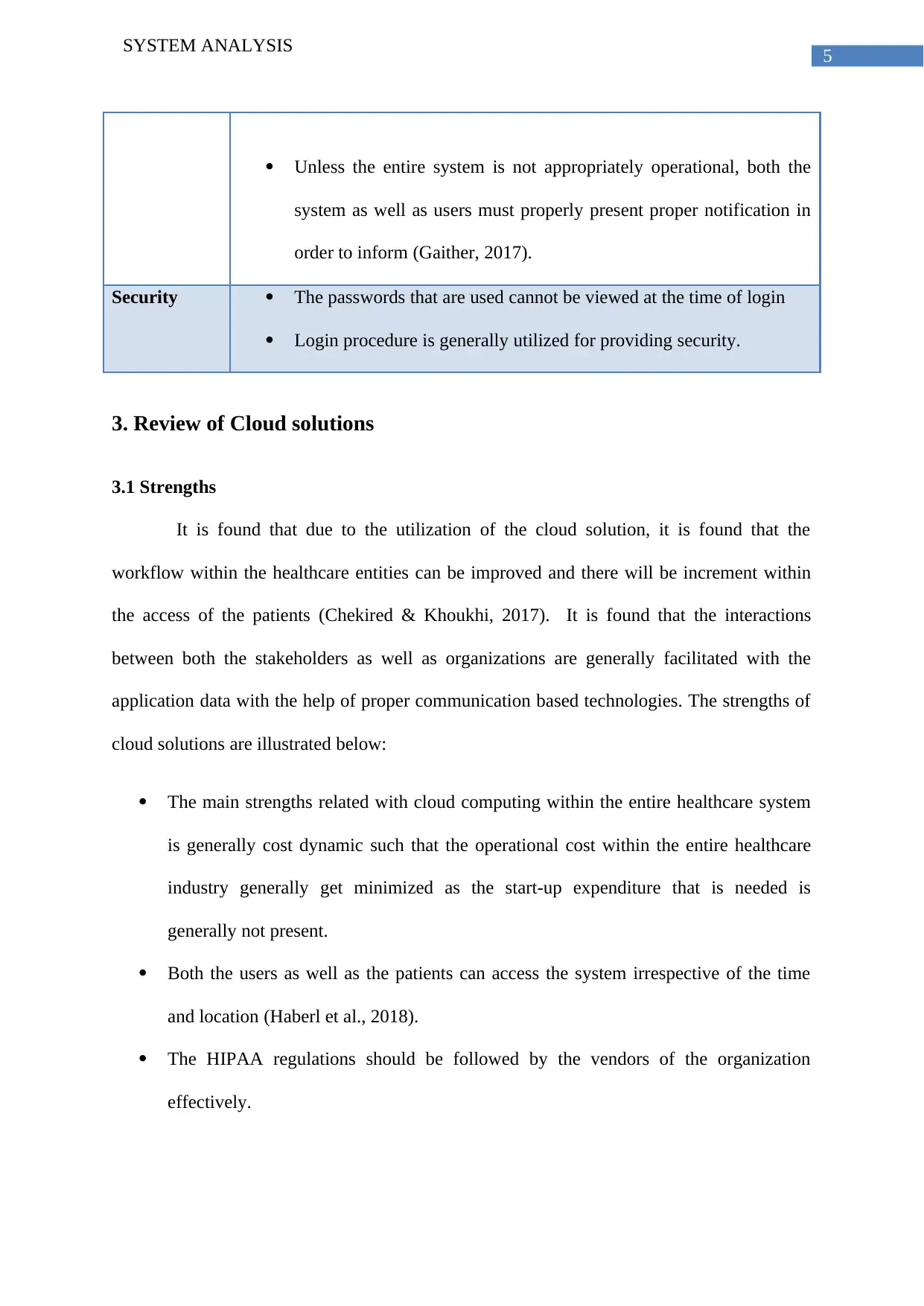
5
SYSTEM ANALYSIS
Unless the entire system is not appropriately operational, both the
system as well as users must properly present proper notification in
order to inform (Gaither, 2017).
Security The passwords that are used cannot be viewed at the time of login
Login procedure is generally utilized for providing security.
3. Review of Cloud solutions
3.1 Strengths
It is found that due to the utilization of the cloud solution, it is found that the
workflow within the healthcare entities can be improved and there will be increment within
the access of the patients (Chekired & Khoukhi, 2017). It is found that the interactions
between both the stakeholders as well as organizations are generally facilitated with the
application data with the help of proper communication based technologies. The strengths of
cloud solutions are illustrated below:
The main strengths related with cloud computing within the entire healthcare system
is generally cost dynamic such that the operational cost within the entire healthcare
industry generally get minimized as the start-up expenditure that is needed is
generally not present.
Both the users as well as the patients can access the system irrespective of the time
and location (Haberl et al., 2018).
The HIPAA regulations should be followed by the vendors of the organization
effectively.
SYSTEM ANALYSIS
Unless the entire system is not appropriately operational, both the
system as well as users must properly present proper notification in
order to inform (Gaither, 2017).
Security The passwords that are used cannot be viewed at the time of login
Login procedure is generally utilized for providing security.
3. Review of Cloud solutions
3.1 Strengths
It is found that due to the utilization of the cloud solution, it is found that the
workflow within the healthcare entities can be improved and there will be increment within
the access of the patients (Chekired & Khoukhi, 2017). It is found that the interactions
between both the stakeholders as well as organizations are generally facilitated with the
application data with the help of proper communication based technologies. The strengths of
cloud solutions are illustrated below:
The main strengths related with cloud computing within the entire healthcare system
is generally cost dynamic such that the operational cost within the entire healthcare
industry generally get minimized as the start-up expenditure that is needed is
generally not present.
Both the users as well as the patients can access the system irrespective of the time
and location (Haberl et al., 2018).
The HIPAA regulations should be followed by the vendors of the organization
effectively.
⊘ This is a preview!⊘
Do you want full access?
Subscribe today to unlock all pages.

Trusted by 1+ million students worldwide
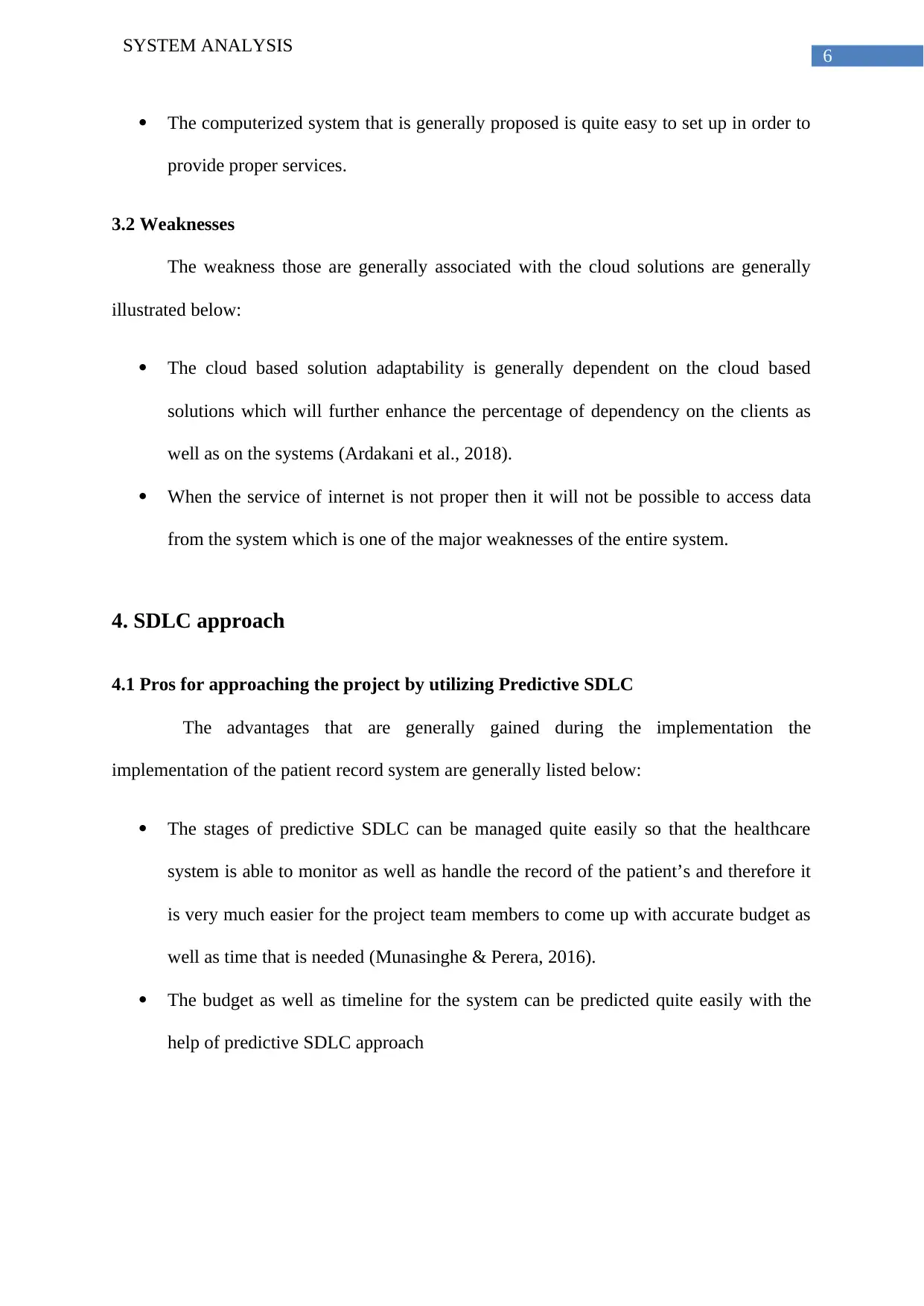
6
SYSTEM ANALYSIS
The computerized system that is generally proposed is quite easy to set up in order to
provide proper services.
3.2 Weaknesses
The weakness those are generally associated with the cloud solutions are generally
illustrated below:
The cloud based solution adaptability is generally dependent on the cloud based
solutions which will further enhance the percentage of dependency on the clients as
well as on the systems (Ardakani et al., 2018).
When the service of internet is not proper then it will not be possible to access data
from the system which is one of the major weaknesses of the entire system.
4. SDLC approach
4.1 Pros for approaching the project by utilizing Predictive SDLC
The advantages that are generally gained during the implementation the
implementation of the patient record system are generally listed below:
The stages of predictive SDLC can be managed quite easily so that the healthcare
system is able to monitor as well as handle the record of the patient’s and therefore it
is very much easier for the project team members to come up with accurate budget as
well as time that is needed (Munasinghe & Perera, 2016).
The budget as well as timeline for the system can be predicted quite easily with the
help of predictive SDLC approach
SYSTEM ANALYSIS
The computerized system that is generally proposed is quite easy to set up in order to
provide proper services.
3.2 Weaknesses
The weakness those are generally associated with the cloud solutions are generally
illustrated below:
The cloud based solution adaptability is generally dependent on the cloud based
solutions which will further enhance the percentage of dependency on the clients as
well as on the systems (Ardakani et al., 2018).
When the service of internet is not proper then it will not be possible to access data
from the system which is one of the major weaknesses of the entire system.
4. SDLC approach
4.1 Pros for approaching the project by utilizing Predictive SDLC
The advantages that are generally gained during the implementation the
implementation of the patient record system are generally listed below:
The stages of predictive SDLC can be managed quite easily so that the healthcare
system is able to monitor as well as handle the record of the patient’s and therefore it
is very much easier for the project team members to come up with accurate budget as
well as time that is needed (Munasinghe & Perera, 2016).
The budget as well as timeline for the system can be predicted quite easily with the
help of predictive SDLC approach
Paraphrase This Document
Need a fresh take? Get an instant paraphrase of this document with our AI Paraphraser
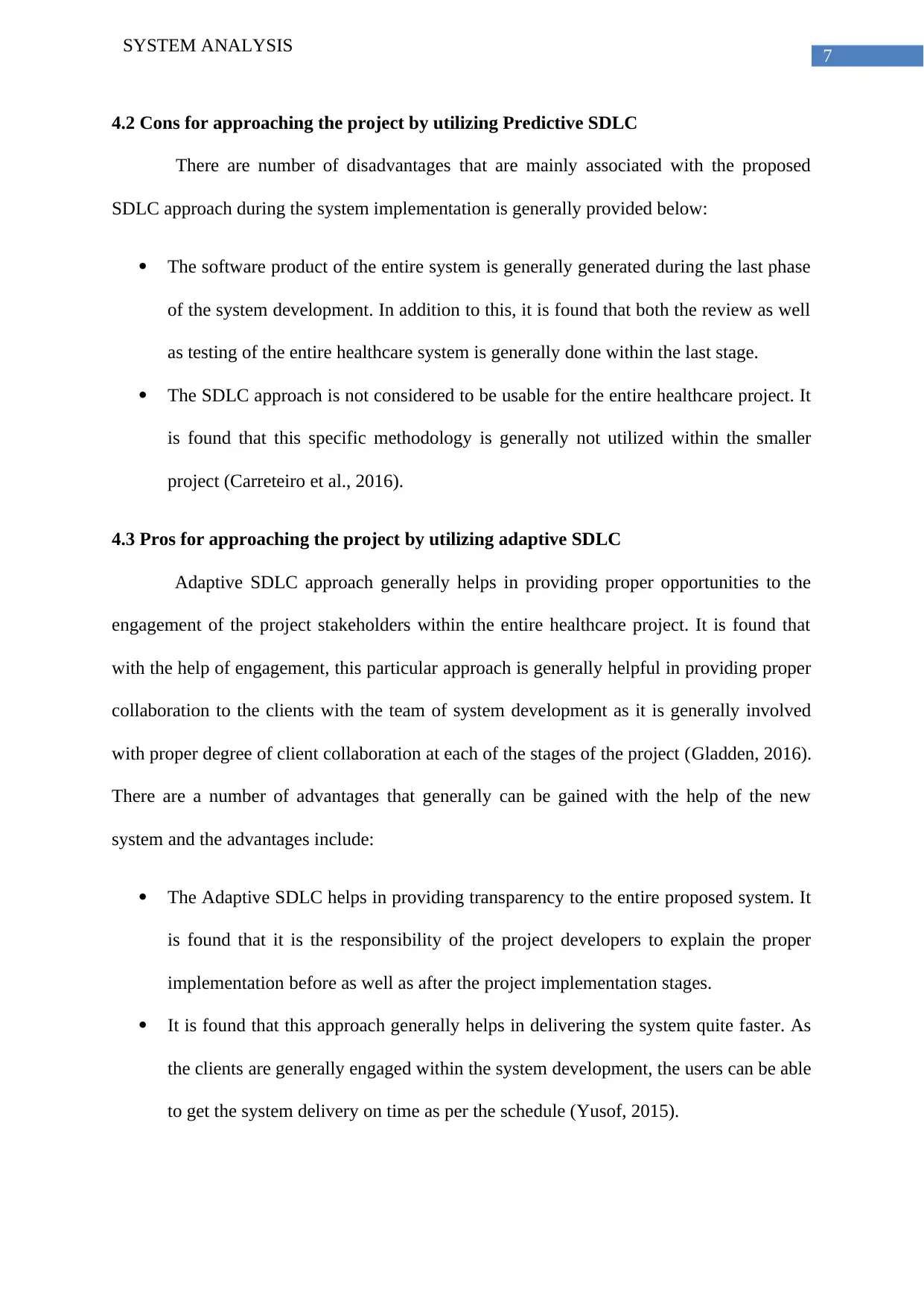
7
SYSTEM ANALYSIS
4.2 Cons for approaching the project by utilizing Predictive SDLC
There are number of disadvantages that are mainly associated with the proposed
SDLC approach during the system implementation is generally provided below:
The software product of the entire system is generally generated during the last phase
of the system development. In addition to this, it is found that both the review as well
as testing of the entire healthcare system is generally done within the last stage.
The SDLC approach is not considered to be usable for the entire healthcare project. It
is found that this specific methodology is generally not utilized within the smaller
project (Carreteiro et al., 2016).
4.3 Pros for approaching the project by utilizing adaptive SDLC
Adaptive SDLC approach generally helps in providing proper opportunities to the
engagement of the project stakeholders within the entire healthcare project. It is found that
with the help of engagement, this particular approach is generally helpful in providing proper
collaboration to the clients with the team of system development as it is generally involved
with proper degree of client collaboration at each of the stages of the project (Gladden, 2016).
There are a number of advantages that generally can be gained with the help of the new
system and the advantages include:
The Adaptive SDLC helps in providing transparency to the entire proposed system. It
is found that it is the responsibility of the project developers to explain the proper
implementation before as well as after the project implementation stages.
It is found that this approach generally helps in delivering the system quite faster. As
the clients are generally engaged within the system development, the users can be able
to get the system delivery on time as per the schedule (Yusof, 2015).
SYSTEM ANALYSIS
4.2 Cons for approaching the project by utilizing Predictive SDLC
There are number of disadvantages that are mainly associated with the proposed
SDLC approach during the system implementation is generally provided below:
The software product of the entire system is generally generated during the last phase
of the system development. In addition to this, it is found that both the review as well
as testing of the entire healthcare system is generally done within the last stage.
The SDLC approach is not considered to be usable for the entire healthcare project. It
is found that this specific methodology is generally not utilized within the smaller
project (Carreteiro et al., 2016).
4.3 Pros for approaching the project by utilizing adaptive SDLC
Adaptive SDLC approach generally helps in providing proper opportunities to the
engagement of the project stakeholders within the entire healthcare project. It is found that
with the help of engagement, this particular approach is generally helpful in providing proper
collaboration to the clients with the team of system development as it is generally involved
with proper degree of client collaboration at each of the stages of the project (Gladden, 2016).
There are a number of advantages that generally can be gained with the help of the new
system and the advantages include:
The Adaptive SDLC helps in providing transparency to the entire proposed system. It
is found that it is the responsibility of the project developers to explain the proper
implementation before as well as after the project implementation stages.
It is found that this approach generally helps in delivering the system quite faster. As
the clients are generally engaged within the system development, the users can be able
to get the system delivery on time as per the schedule (Yusof, 2015).
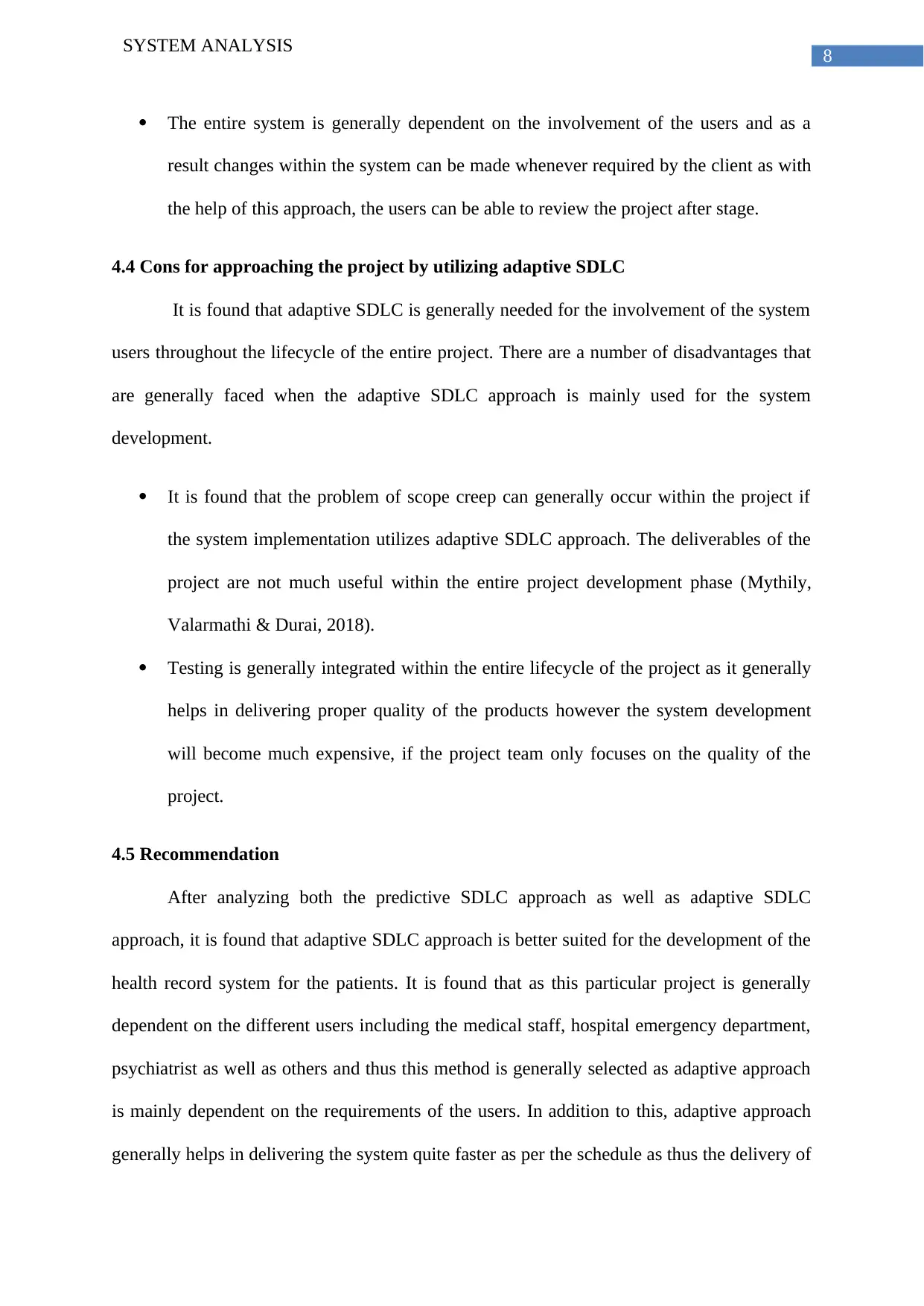
8
SYSTEM ANALYSIS
The entire system is generally dependent on the involvement of the users and as a
result changes within the system can be made whenever required by the client as with
the help of this approach, the users can be able to review the project after stage.
4.4 Cons for approaching the project by utilizing adaptive SDLC
It is found that adaptive SDLC is generally needed for the involvement of the system
users throughout the lifecycle of the entire project. There are a number of disadvantages that
are generally faced when the adaptive SDLC approach is mainly used for the system
development.
It is found that the problem of scope creep can generally occur within the project if
the system implementation utilizes adaptive SDLC approach. The deliverables of the
project are not much useful within the entire project development phase (Mythily,
Valarmathi & Durai, 2018).
Testing is generally integrated within the entire lifecycle of the project as it generally
helps in delivering proper quality of the products however the system development
will become much expensive, if the project team only focuses on the quality of the
project.
4.5 Recommendation
After analyzing both the predictive SDLC approach as well as adaptive SDLC
approach, it is found that adaptive SDLC approach is better suited for the development of the
health record system for the patients. It is found that as this particular project is generally
dependent on the different users including the medical staff, hospital emergency department,
psychiatrist as well as others and thus this method is generally selected as adaptive approach
is mainly dependent on the requirements of the users. In addition to this, adaptive approach
generally helps in delivering the system quite faster as per the schedule as thus the delivery of
SYSTEM ANALYSIS
The entire system is generally dependent on the involvement of the users and as a
result changes within the system can be made whenever required by the client as with
the help of this approach, the users can be able to review the project after stage.
4.4 Cons for approaching the project by utilizing adaptive SDLC
It is found that adaptive SDLC is generally needed for the involvement of the system
users throughout the lifecycle of the entire project. There are a number of disadvantages that
are generally faced when the adaptive SDLC approach is mainly used for the system
development.
It is found that the problem of scope creep can generally occur within the project if
the system implementation utilizes adaptive SDLC approach. The deliverables of the
project are not much useful within the entire project development phase (Mythily,
Valarmathi & Durai, 2018).
Testing is generally integrated within the entire lifecycle of the project as it generally
helps in delivering proper quality of the products however the system development
will become much expensive, if the project team only focuses on the quality of the
project.
4.5 Recommendation
After analyzing both the predictive SDLC approach as well as adaptive SDLC
approach, it is found that adaptive SDLC approach is better suited for the development of the
health record system for the patients. It is found that as this particular project is generally
dependent on the different users including the medical staff, hospital emergency department,
psychiatrist as well as others and thus this method is generally selected as adaptive approach
is mainly dependent on the requirements of the users. In addition to this, adaptive approach
generally helps in delivering the system quite faster as per the schedule as thus the delivery of
⊘ This is a preview!⊘
Do you want full access?
Subscribe today to unlock all pages.

Trusted by 1+ million students worldwide
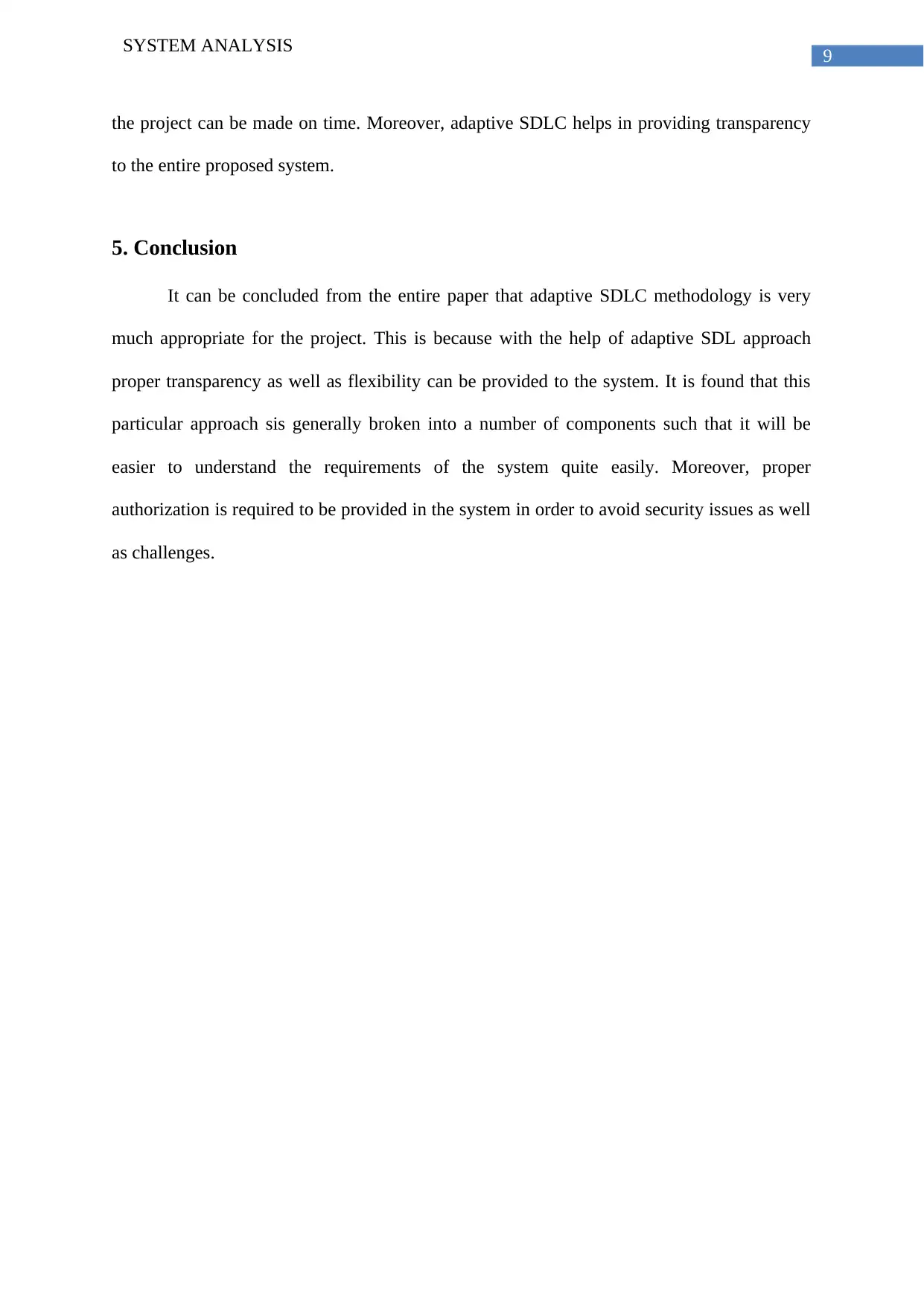
9
SYSTEM ANALYSIS
the project can be made on time. Moreover, adaptive SDLC helps in providing transparency
to the entire proposed system.
5. Conclusion
It can be concluded from the entire paper that adaptive SDLC methodology is very
much appropriate for the project. This is because with the help of adaptive SDL approach
proper transparency as well as flexibility can be provided to the system. It is found that this
particular approach sis generally broken into a number of components such that it will be
easier to understand the requirements of the system quite easily. Moreover, proper
authorization is required to be provided in the system in order to avoid security issues as well
as challenges.
SYSTEM ANALYSIS
the project can be made on time. Moreover, adaptive SDLC helps in providing transparency
to the entire proposed system.
5. Conclusion
It can be concluded from the entire paper that adaptive SDLC methodology is very
much appropriate for the project. This is because with the help of adaptive SDL approach
proper transparency as well as flexibility can be provided to the system. It is found that this
particular approach sis generally broken into a number of components such that it will be
easier to understand the requirements of the system quite easily. Moreover, proper
authorization is required to be provided in the system in order to avoid security issues as well
as challenges.
Paraphrase This Document
Need a fresh take? Get an instant paraphrase of this document with our AI Paraphraser
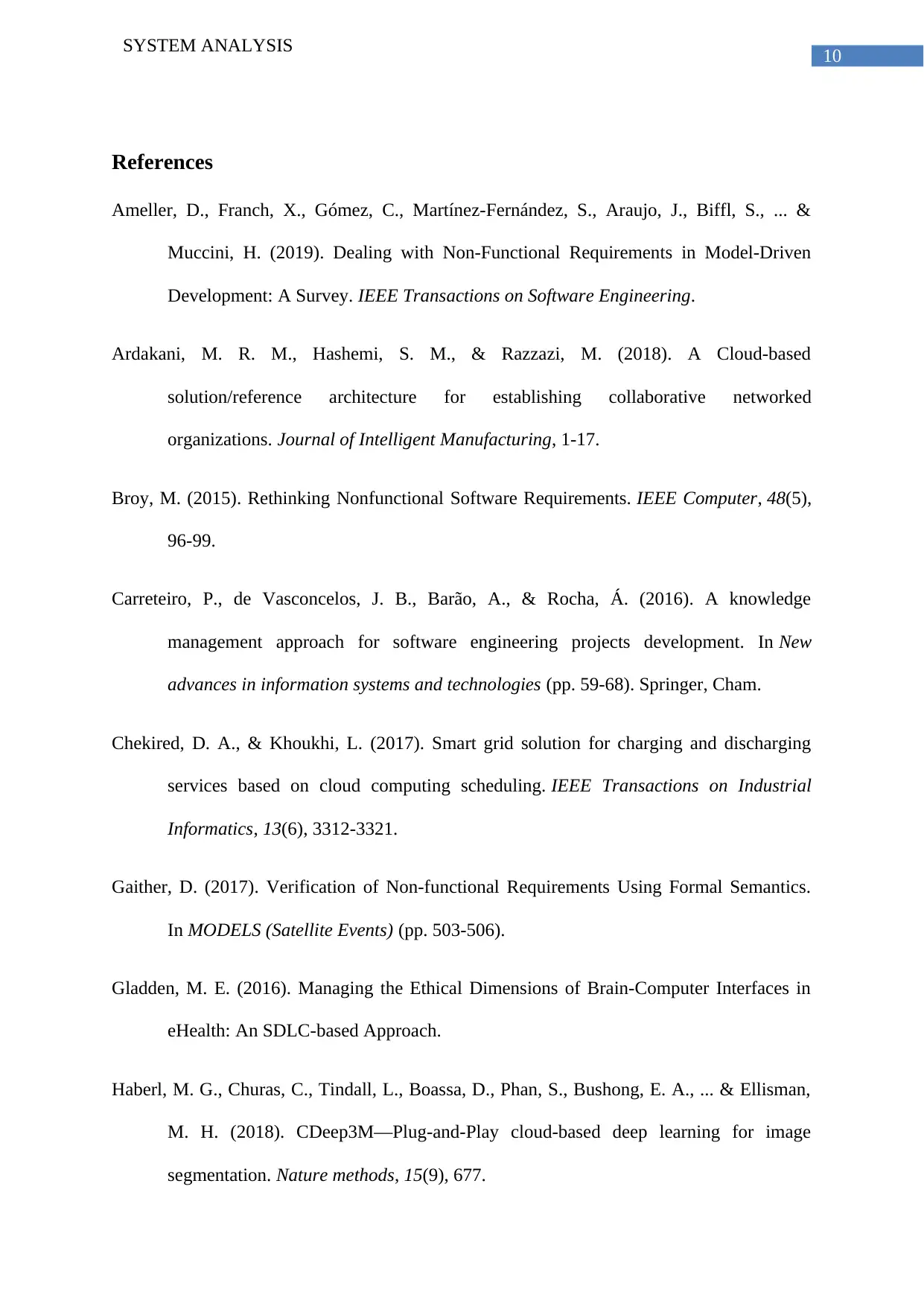
10
SYSTEM ANALYSIS
References
Ameller, D., Franch, X., Gómez, C., Martínez-Fernández, S., Araujo, J., Biffl, S., ... &
Muccini, H. (2019). Dealing with Non-Functional Requirements in Model-Driven
Development: A Survey. IEEE Transactions on Software Engineering.
Ardakani, M. R. M., Hashemi, S. M., & Razzazi, M. (2018). A Cloud-based
solution/reference architecture for establishing collaborative networked
organizations. Journal of Intelligent Manufacturing, 1-17.
Broy, M. (2015). Rethinking Nonfunctional Software Requirements. IEEE Computer, 48(5),
96-99.
Carreteiro, P., de Vasconcelos, J. B., Barão, A., & Rocha, Á. (2016). A knowledge
management approach for software engineering projects development. In New
advances in information systems and technologies (pp. 59-68). Springer, Cham.
Chekired, D. A., & Khoukhi, L. (2017). Smart grid solution for charging and discharging
services based on cloud computing scheduling. IEEE Transactions on Industrial
Informatics, 13(6), 3312-3321.
Gaither, D. (2017). Verification of Non-functional Requirements Using Formal Semantics.
In MODELS (Satellite Events) (pp. 503-506).
Gladden, M. E. (2016). Managing the Ethical Dimensions of Brain-Computer Interfaces in
eHealth: An SDLC-based Approach.
Haberl, M. G., Churas, C., Tindall, L., Boassa, D., Phan, S., Bushong, E. A., ... & Ellisman,
M. H. (2018). CDeep3M—Plug-and-Play cloud-based deep learning for image
segmentation. Nature methods, 15(9), 677.
SYSTEM ANALYSIS
References
Ameller, D., Franch, X., Gómez, C., Martínez-Fernández, S., Araujo, J., Biffl, S., ... &
Muccini, H. (2019). Dealing with Non-Functional Requirements in Model-Driven
Development: A Survey. IEEE Transactions on Software Engineering.
Ardakani, M. R. M., Hashemi, S. M., & Razzazi, M. (2018). A Cloud-based
solution/reference architecture for establishing collaborative networked
organizations. Journal of Intelligent Manufacturing, 1-17.
Broy, M. (2015). Rethinking Nonfunctional Software Requirements. IEEE Computer, 48(5),
96-99.
Carreteiro, P., de Vasconcelos, J. B., Barão, A., & Rocha, Á. (2016). A knowledge
management approach for software engineering projects development. In New
advances in information systems and technologies (pp. 59-68). Springer, Cham.
Chekired, D. A., & Khoukhi, L. (2017). Smart grid solution for charging and discharging
services based on cloud computing scheduling. IEEE Transactions on Industrial
Informatics, 13(6), 3312-3321.
Gaither, D. (2017). Verification of Non-functional Requirements Using Formal Semantics.
In MODELS (Satellite Events) (pp. 503-506).
Gladden, M. E. (2016). Managing the Ethical Dimensions of Brain-Computer Interfaces in
eHealth: An SDLC-based Approach.
Haberl, M. G., Churas, C., Tindall, L., Boassa, D., Phan, S., Bushong, E. A., ... & Ellisman,
M. H. (2018). CDeep3M—Plug-and-Play cloud-based deep learning for image
segmentation. Nature methods, 15(9), 677.
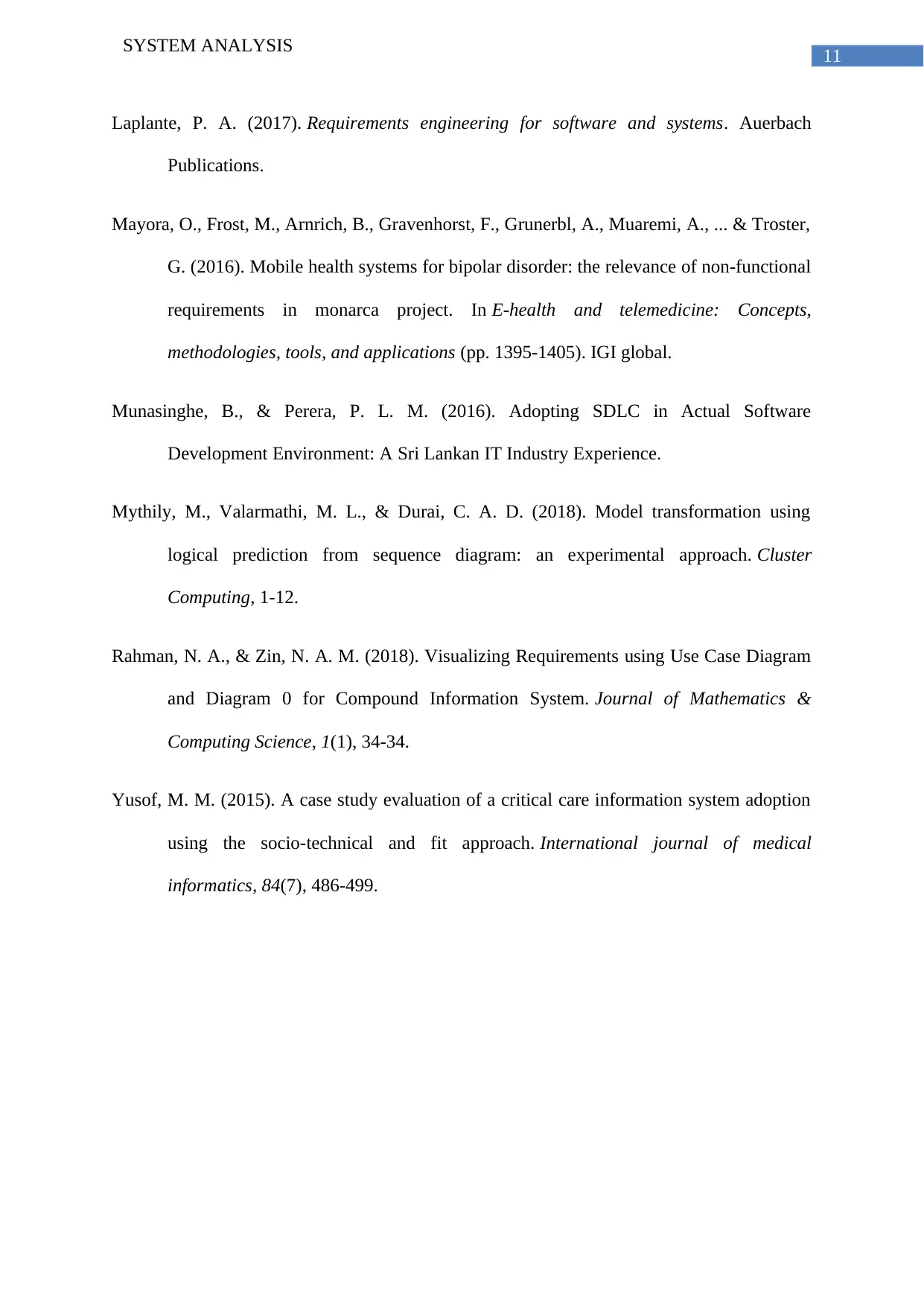
11
SYSTEM ANALYSIS
Laplante, P. A. (2017). Requirements engineering for software and systems. Auerbach
Publications.
Mayora, O., Frost, M., Arnrich, B., Gravenhorst, F., Grunerbl, A., Muaremi, A., ... & Troster,
G. (2016). Mobile health systems for bipolar disorder: the relevance of non-functional
requirements in monarca project. In E-health and telemedicine: Concepts,
methodologies, tools, and applications (pp. 1395-1405). IGI global.
Munasinghe, B., & Perera, P. L. M. (2016). Adopting SDLC in Actual Software
Development Environment: A Sri Lankan IT Industry Experience.
Mythily, M., Valarmathi, M. L., & Durai, C. A. D. (2018). Model transformation using
logical prediction from sequence diagram: an experimental approach. Cluster
Computing, 1-12.
Rahman, N. A., & Zin, N. A. M. (2018). Visualizing Requirements using Use Case Diagram
and Diagram 0 for Compound Information System. Journal of Mathematics &
Computing Science, 1(1), 34-34.
Yusof, M. M. (2015). A case study evaluation of a critical care information system adoption
using the socio-technical and fit approach. International journal of medical
informatics, 84(7), 486-499.
SYSTEM ANALYSIS
Laplante, P. A. (2017). Requirements engineering for software and systems. Auerbach
Publications.
Mayora, O., Frost, M., Arnrich, B., Gravenhorst, F., Grunerbl, A., Muaremi, A., ... & Troster,
G. (2016). Mobile health systems for bipolar disorder: the relevance of non-functional
requirements in monarca project. In E-health and telemedicine: Concepts,
methodologies, tools, and applications (pp. 1395-1405). IGI global.
Munasinghe, B., & Perera, P. L. M. (2016). Adopting SDLC in Actual Software
Development Environment: A Sri Lankan IT Industry Experience.
Mythily, M., Valarmathi, M. L., & Durai, C. A. D. (2018). Model transformation using
logical prediction from sequence diagram: an experimental approach. Cluster
Computing, 1-12.
Rahman, N. A., & Zin, N. A. M. (2018). Visualizing Requirements using Use Case Diagram
and Diagram 0 for Compound Information System. Journal of Mathematics &
Computing Science, 1(1), 34-34.
Yusof, M. M. (2015). A case study evaluation of a critical care information system adoption
using the socio-technical and fit approach. International journal of medical
informatics, 84(7), 486-499.
⊘ This is a preview!⊘
Do you want full access?
Subscribe today to unlock all pages.

Trusted by 1+ million students worldwide
1 out of 12
Related Documents
Your All-in-One AI-Powered Toolkit for Academic Success.
+13062052269
info@desklib.com
Available 24*7 on WhatsApp / Email
![[object Object]](/_next/static/media/star-bottom.7253800d.svg)
Unlock your academic potential
Copyright © 2020–2025 A2Z Services. All Rights Reserved. Developed and managed by ZUCOL.





